Pet Birds: Ultimate Guide to Care and Enrichment


Intro
Pet birds can be delightful companions. Their behavior, unique personalities, and vibrant colors can enrich lives significantly. However, owning a pet bird comes with unique responsibilities. Both novice and experienced owners need to understand several aspects to ensure their pet birds thrive. This guide aims to give comprehensive insights into the significant elements of care and enrichment for pet birds. From daily routines to understanding their habits, every detail plays a crucial role in fostering their overall well-being.
Care Tips
Daily Care Routines
A structured daily routine is vital for a pet bird's health. Make sure to allocate time for feeding, cleaning, and interactive play. Feeding should happen at the same time each day to provide stability. A bird’s choice of food cultivates their behavior, so fresh fruits, vegetables, and quality bird seed should be part of the regimen. Additionally, observe their eating habits to adjust their diet as necessary.
Cage Setup and Maintenance
The cage is a bird’s primary living environment. It must be spacious enough for movement and equipped with various perches, toys, and feeding stations. Follow safety guidelines by avoiding toxic materials. Regularly check for sharp edges that could harm your bird. For maintenance, change the bedding weekly, and thoroughly clean the cage monthly to avoid bacteria buildup.
Hygiene and Cleaning Practices
Birds are sensitive to their environments. Regular cleaning is essential. Remove waste daily and disinfect feeding and water containers to maintain hygiene. An unclean environment can lead to health issues. It is wise to wear gloves while cleaning to prevent the spread of bacteria.
Seasonal Care Adjustments
Changes in temperature can affect birds considerably. During colder months, ensure they are in a warm area; avoid drafts which could lead to illness. Inhot weather, provide ample hydration. Additionally, adjust their playtime; too hot or too cold can lead to lethargy.
Behavioral Insights
Understanding Bird Body Language
Birds communicate primarily through body language. It’s important to learn signals, such as flapping, puffing, and wing position which convey feelings. An alert, excited bird will often sing or chirp, whereas a frightened bird will puff up and may conceal itself. Understanding these signs enhances interaction and reduces stress.
Common Behavioral Issues and Solutions
Some birds exhibit behavioral problems. Chewing is common, and it can be managed by providing appropriate toys. If a bird becomes overly aggressive, spend time understanding triggers. Gradual exposure to new situations often reduces anxiety.
Positive Reinforcement Techniques
Reward-based training is effective. Use treats like sunflower seeds when they demonstrate desirable behavior. This cements positive actions and improves your bird’s overall responsiveness to commands or requests.
Social Interaction Needs
Birds thrive on interaction. They are social creatures needing companionship, either with their owner or with other birds. A solitary bird may become withdrawn or demonstrate signs of depression. Understand the balance of interaction needed according to the species’ social nature.
Nutrition Guides
Essential Diet Components
Birds require a well-balanced diet. High-quality pellets should form about 70-80% of their diet, supplemented with fresh fruits and vegetables. Experiment with a variety so your bird receives all necessary nutrients.
Safe and Toxic Foods
It is critical to know what foods are harmful. Avoid giving chocolate, caffeine, and some fruits' pits like avocado and apple seeds. Such foods can be fatal.
Supplements and Treats
Consider incorporating nutritional supplements, especially for older birds. Offering occasional treats is acceptable; however, these should not exceed 10% of the diet to maintain their health.
Feeding Strategies for Different Species
Different species may have specific needs. Budgies thrive on seed mixes, while cockatiels often prefer pellets. Know the characteristics of each species to optimize their diet.
Wellness and Health
Routine Health Checkups
Regular checkups are essential for proactive health management. Establish relationships with avian vets who understand bird physiology. Schedule exams every six months for routine evaluations.
Identifying Symptoms of Illness
Early detection of health symptoms can prevent serious conditions. Key signs to watch for include sudden changes in plumage appearance, lethargy, lack of appetite, or unusual vocalization. Keep a close eye on their behavior.
Preventative Care and Vaccinations
Follow veterinarian recommendations for vaccinations and health plans. Regular cleaning reduces disease spread. Maintain proper levels humidity and light. Optimal conditions contribute to a bird’s longevity.
Mental and Emotional Well-being
Mental stimulation is equally essential as physical health. Provide various activities to keep your bird engaged. A stressed bird withdraws; offer a sanctuary environment where they feel secure.
Enriching Activities
Toys and Playtime Ideas
Invest in different toys suitable for your bird's size and mental capabilities. Rotate them to maintain interest. Establish playtime sessions where birds can explore and socialize.
Training and Tricks
Use training sessions not just for behavior management but als for companionship enhancement. Simple tricks, like wave or step up, create rich interaction. Positive reinforcement methods produce delightful and satisfying results.
Outdoor Activities and Interaction
Allowing your bird to interact outside under close supervision can be beneficial for them. Consider using harnesses for safe exploration in a natural environment.
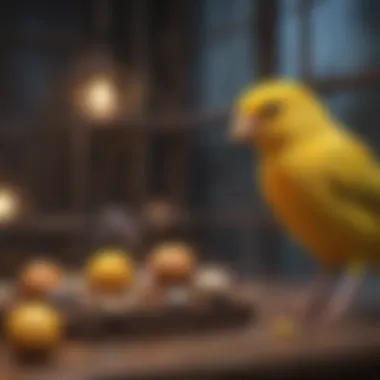
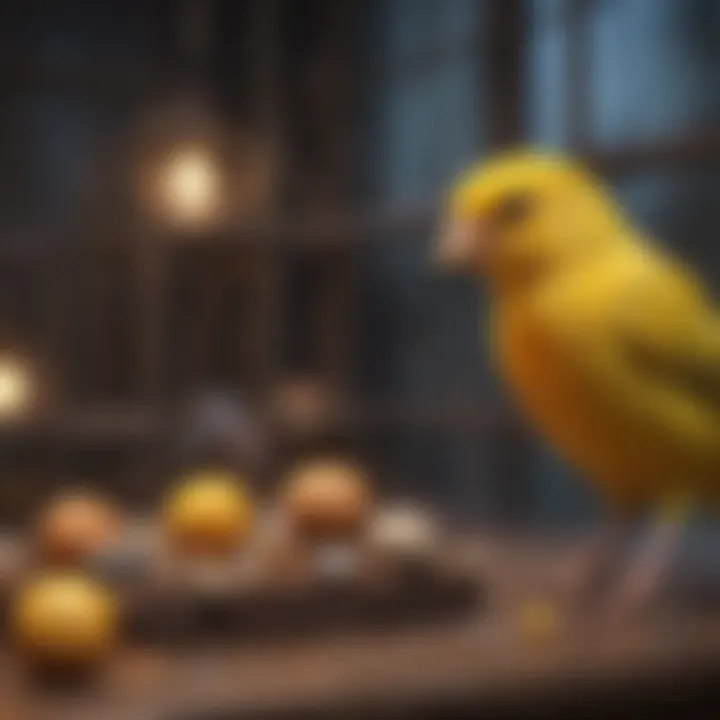
DIY Projects for Mental Stimulation
Getting creative enhances engagement. Simple projects like foraging toys using household items provide birds with challenges and stimulation. Here’s an idea that is simple:
This challenge encourages natural foraging instincts. Present many options to enrich their environment. Learn to evaluate and adapt as necessary.
Understand your pet bird's needs is key to providing a loving and healthy environment. Ultimately, enhanced understanding enriches the relationship between bird and owner.
Prelims to Pet Birds
Pet birds have gained prominence as cherished companions. Their diversity, charm, and interactive nature make them appealing to pet owners. Understanding the underlying motivations for keeping birds can enhance one’s approach to care and enrichment.
Chinese philosopher Confucius said, "People should care for their animals as they do for their friends." This perspective food the importance of providing a nurturing environment for pet birds.
A few reasons many choose birds as pets include their relatively low space requirements, expressive behaviors, and ability for social bonds. For people living in smaller homes or apartments, birds can offer companionship without the extensive responsibilities involved in larger pets, like dogs or cats. This attractiveness positions them uniquely in the realm of pet ownership.
Understanding the Attraction
Several factors draw people towards keeping birds as pets. First is their social and intelligent nature. Many species enjoy interacting with humans, and this companionship can greatly enhance the life qualities of a bird.
Another aspect is their colorful appearance. Birds like parakeets and canaries come in a range of colors that can brighten any space. Besides their visual appeal, their songs can provide comforting background noise.
Finally, there is a cultural aspect. In many traditions, birds symbolize freedom and beauty, evoking qualities pet owners admire or aspire to resonate with in their lives. Understanding these facets can help owners form a more connected and rewarding relationship with their avian companions.
Overview of Popular Species
Choosing the right species is critical for successful bird ownership. Different birds offer unique characteristics. This can align better or worse with individual owners' lifestyles. Below are several popular varieties that many choose for their enriching companionship.
Parakeets
Parakeets are small and friendly birds that are widely regarded for their engaging personalities. Often known as budgies, they can be very social. Their small size require less space, easing the setup for new bird owners.
The key characteristic of parakeets is their ability to learn songs and mimic sounds, which makes them fun to interact with. They provide both social interaction and mental stimulation, making them a popular choice. The only downside is that they can be quite noisy as their vocalizations can fill the household. Nonetheless, their charm often overshadows this behavior.
Cockatiels
Cockatiels are medium-sized parrots that possess a sophisticated demeanor mixed with a playful side. They are well-loved for their quirky antics and can form strong bonds with their owners. One of the key aspects of cockatiels is their capacity to whistle and mimic sounds, which adds an entertaining aspect to life with them.
The unique feature of cockatiels involves their crest feathers that raise and lower, depending on their mood. They require a bit more engagement and interaction daily; otherwise, they may become lonely. Their charming behavior almost always outweighs the light attention requirements concerning commitment.
Amazon Parrots
Amazon parrots are known for their playful and boisterous nature. These birds are larger than parakeets or cockatiels, making proper flight and space essential. Their attractiveness lies in their ability to mimic human speech quite effectively, leading them to be vibrant communicators.
Importantly, Amazon parrots thrive on social interaction, requiring committed daily attention and activity. If provided with the right conditions, they exhibit a long lifespan that can almost lead to emotional connections similar to those shared with humans. Their challenge rests with their potential for developing undesirable behaviors due to boredom or loneliness, necessitating into decisive actions for sustained wellness.
Canaries
Canaries are known for their beautiful singing. Their specific aspect is their unique vocalization abilities, often resonating in multiple ways. This artistically pleasing sound stands as an optimal feature for owners who appreciate pleasant backgrounds from pets.
Ranking among smaller birds, canaries require concern for handling preferences – they tend to prefer solitude or cohabitating only with their kind. While they make excellent singing companions, they may lack the interpersonal bonds characteristic of other birds like parrots. Canaries provide enrichment predominantly through their music, often relieving stress even merely by being present.
Lovebirds
Lovebirds are small but deeply affectionate. They're known for their playful mannerisms and social bonding tendencies. Their strength of loyalty often leads participants to view them as excellent intimate companions.
The remarkable feature of lovebirds lies in their need for companionship. It's essential to ensure that if a bond to a human is not strong, they might need to live with a partner, as lovebirds thrive better in pairs. However, their avian social traits may include substantial vocalizations too, compensating for their paired characteristic by adding engagement.
By contemplating these aspects outlined throughout this section, potential owners can derive a stronger understanding of pet bird life. Each species presents unique qualities worth evaluating for anyone interested in extending multi-dimensional companionship.
Setting Up Your Aviary
Setting up an appropriate aviary is crucial for the well-being and happiness of pet birds. A well-thought-out environment provides safety, comfort, and enrichment, allowing birds to live enriched lives. Fittingly designed cages and surroundings can significantly enhance both their physical and psychological health. As pet owners, your responsibility extends beyond basic care. Understanding how to optimally provide for your bird's habitat can promote longevity and happiness.
Choosing the Right Cage
When it comes to petty birds, the cage is their sanctuary. It must be spacious enough for movement and natural behaviors. Birds need room to stretch their wings and explore. The size varies depending on the species. For example, parrots require larger cages than canaries. Generally,
- Larger surprises patrons, enriched-stimulating.
- More space stimulating healthy foraging behaviours.
Besides sizing, material matters. Stainless steel is often preferable as it's durable and easier to clean. Avoid unsafe materials like toxic coatings. Both vertical space and horizontal structure are essential. Each bird exhibits differing tendencies for climbing and exploring, thus, some categories like Amazon parrots enjoy perches higher up. Determine the ideal shape for your specific birds before making a purchase.
Essential Accessories and Toys
Accessories play a major role in creating a fulfilling environment. A variety of toys enrich the bird's life, catering to their natural instincts. Some essential considerations include:
- Perches: Variety in sizes and materials engaging it,
- Food and water dishes: Make sure they are securely attached and in place. Same importance applies to placement that’s easy access but not overly exposed.
- Toys: Provide mental stimulation. Some good choices are shreddable toys, mirrors, and foraging balls.
- Swings and ladders: Promotes physical activity, contributing to their exercise need.
Each bird will have unique preferences, so observe your pet and see what engages it most. An ideal environment should capture both physical activity and mental stimulation. Having a rich array of accessories can defer boredom and result in a stylish, healthy habitat.
The Importance of Natural Light
Brightness plays an integral role in every bird's health. Natural light fosters a sense of time, affecting nesting behavior and overall well-being. Birds exposed to light may display better mental alertness and happier demeanor.
Advantages of natural light include:
- Vitamin D synthesis: this vitamin is responsible for calcium absorption. Sharp attention to this is necessary to avoid health complications.
- Behavior regulation: Important for activity pattern and can impact hormonal cycles beneficially.
However, while days in sunlight are induceful, being monitored is key too. Too much-direct sunlight can create heat stress. Place the aviary where light is sufficient but shaded escape from intensity occur during hot coverage.
In summary, offering careful aviary setup helps propel overall quality of life for our cherished pet birds.”
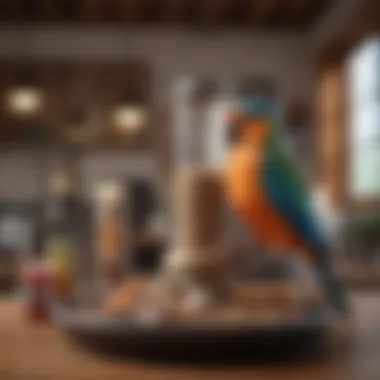
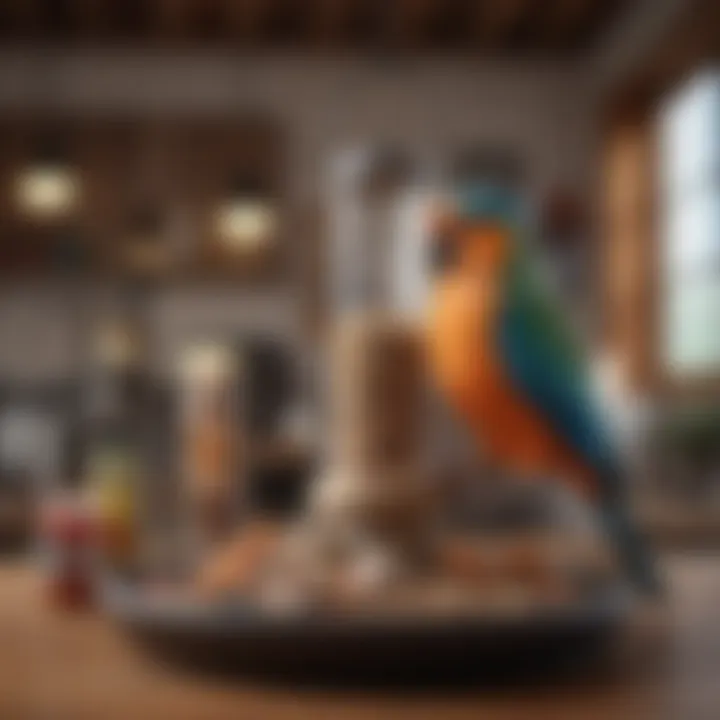
Taking these elements into consideration while setting up your aviary will lead you to creating an environment where your birds thrive physically and emotionally. Balance space, interpersonal engagement, and exposure to natural elements to strengthen their bond with you while focusing on their happiness.
Feeding Your Pet Birds
Feeding your pet birds properly is crucial for their health and longevity. A balanced diet not only supports physical well-being but also influences overall behavior. It is essential to understand that different species have varying nutritional requirements. Awareness of this helps owners choose suitable food options effectively. Correct feeding practices lead to happier, more active, and healthier birds.
Understanding Nutritional Needs
Birds, like any other pets, need a well-rounded diet. Nutritional content affects appetite, energy levels, and even mood. Essential nutrients must include proteins, fats, carbohydrates, vitamins, and minerals. For instance, daily soft foods may not meet all the birds’ needs due to potential deficiencies. Therefore, it requires a diligent approach to know what your pet specifically requires.
Maintaining health through hydration is also vital. Fresh water should always be accessible. Clean, fresh water supports digestion and enhances overall metabolic functions for birds.
Types of Bird Food
Pellets
Pellets are a staple in many bird diets. Their design aims to be nutritionally complete, offering essential nutrients a bird needs. Most brands provide fortified pellets suitable for different bird species. Pellets ensure that birds receive balanced nutrition in each bite. This makes them a benefical and preferred choice for many owners. However, not all birds immediately accept this food type. Sometimes gentle coaxing or mixing with seeds is needed at first.
While eating only pellets can sometimes result in boredom, mixing them with other food types might counterbalance this.
Seeds
Seeds can be appealing and enjoyable for a variety of pet birds. They are often the first choice for owners when considering snacks and treats. Seeds contain fats and caloric values that may be suitable in moderation. Nonetheless, reliance on a seed diet alone may lead to nutritional imbalances. Many birds can develop obesity and other health issues from higher calorie intake. Rotating seeds with other food options is beneficial in the long run.
Providing different types will involve personal observation as birds may prefer certain ones over others. Luckily, the challenge of figuring out is part of the enjoyment of being a bird owner.
Fresh Fruits and Vegetables
Incorporating fresh fruits and vegetables contributes vitamins and minerals essential for health. Leafy greens, for example, are vital sources of fiber and antioxidants. Some common choices such as kale, spinach, or carrots work well.
Additionally, fruits add natural sugars that are excellent for energy. Cut small pieces for easier access and ensure they are organic when possible. Some owners also blend fruits into her diets for variety. However, high sugar foods like bananas or grapes should only be given sparingly, always maintaining moderation to avoid health risks.
Avoiding Toxic Foods
Certain foods can prove hazardous to birds. Familiarizing yourself with these can save your pet from serious harm. Common toxic items include avocado, chocolate, caffeine, and alcohol. These deleterious substances can cause sudden illnesses or worse outcomes.
- Regarding toxic foods, consult veterinary sources like the American Pet Bird Association. It contains indispensable information to prevent accidents.
- Keeping track of what your bird eats helps identify potential medications for symptoms if something goes wrong.
Remember, it is always better to err on the side of caution with your bird's diet. Preferring preventive measures helps establish a long-lasting bond between pets and owners through trust and care.
Maintaining an appropriate diet promises great rewards. Consequently, attention to detail can closely reflect in behavior and ensemble of health you see in your pet bird over time.
Behavioral Insights
Understanding the behavior of pet birds is crucial for any owner aiming to foster a harmonious relationship with their feathered companions. Behavior insights help in recognizing the natural instincts of birds and the various signals they express. This knowledge enables owners to provide appropriate responses, enriching the birds’ lives while simultaneously ensuring their well-being. By paying attention to behavioral cues, you can strengthen the bond with your pet bird, prevent issues, and create an overall positive environment.
Understanding Body Language
Birds communicate mainly through body language. Their posture, wing position, and movement convey their feelings and emotions. For instance, a bird puffing up or holding its wings slightly away from its body may indicate excitement or aggression. Conversely, a bird hiding its head under its wing shows discomfort or sleepiness. Recognizing these signs allows the owner to respond appropriately, leading to a much healthier interaction. Moreover, observing your bird's body language provides insights into stress levels or potential illnesses, guiding owners to take proactive measures.
Common Behavioral Issues
Some behaviors in pet birds may not align with the owner’s expectations and can lead to misunderstandings or frustration. Understanding these behaviors and their causes is essential for effective management.
Excessive Screaming
Excessive screaming is a common issue in many pet birds, often signaling distress or demand for attention. This behavior can substantially challenge the togetherness enjoyed between birds and their owners, affecting the household’s tranquility. Screaming usually indicates a lack of stimulation or social interaction. Understanding this draws attention to the bird's needs for social companionship and mental engagement. Effective remedies for excessive screaming include structured interaction, play, and environmental enrichment, all reinforced through proper training techniques.
Plucking Feathers
Plucking feathers is a distressing behavioral issue often seen in pet birds, signaling a variety of issues ranging from boredom to stress. Birds are natural preeners; however, excessive plucking disrupts the feathering pattern and can lead to serious health risks. Recognizing this behavior as a cry for help can help mitigate further incidents. Addressing root causes such as environment enrichment, social companionship, and providing safe, interactive toys are vital strategies to promote a healthy lifestyle for feathered companions. Moreover, consistent vet advice can add layers of prevention against feather plucking.
Aggression
Aggression can arise when birds feel threatened or dominant. Understanding what triggers aggressive behavior will lead to better management of these situations. Typical expressions of aggression include biting or loud squawking. Such displays stem from stress, environment changes or lack of bonding with the owner. Strategies to combat aggression involve patient interaction, gradual trust-building exercises, and ensuring the bird feels secure in its surroundings. Discovering personal triggers for aggression will benefit in formulating effective strategies, giving insights into healthy behavioral adjustments.
Positive Reinforcement Techniques
Enhancing the bond with pet birds often includes incorporating positive reinforcement techniques. Rewarding desirable behaviors with treats, praise or toys encourages birds to repeat attentive behaviors. This method builds trust and creates a nurturing environment. By desensitizing the bird to certain feared situations through gradual engagements paired with rewards, owners can shape positive behavior over time.
In summary, an understanding of bird behavior is pivotal in assisting owners to nurture healthy and happy pet birds. By recognizing their behavioral cues and employing appropriate techniques in response, owners can minimize misunderstandings and face challenges head-on.
Health and Wellness
The health and wellness of pet birds is crucial for their longevity and happiness. Proper care involves understanding their unique needs. Birds can be particularly sensitive to their environments. This section discusses essential practices for maintaining the well-being of your avian companions and offers insights that every bird owner should consider to keep their birds healthy.
Recognizing Signs of Illness
Birds hide their discomfort well, making it challenging for owners to detect early signs of illness. Therefore, vigilance is key. Typical indicators may include:
- Changes in droppings: Version malfunctions can indicate health issues.
- Ruffled feathers: This can signal discomfort or illness.
- Excessive sleeping: An indication that they might not feel well.
- Changes in activity level: Lethargy or hyperactivity should be concerning.
- Behavioral changes: If they are more irritable or withdrawn, it may be a sign of distress.
Monitoring these signs regularly helps ensure timely intervention and usage of veterinary services when needed. The sooner an issue is recognized, the greater the chance of effective treatment.
Routine Care and Checkups
Routine preventive care is essential to keep birds thriving. Regular check-ups with an avian vet ensure that issues can be identified before they develop into serious problems. Recommended practices include:
- Annual health check: These may involve physical examinations, checking for parasites, and recommending vaccinations.
- Weight monitoring: Regular measurements help track health concerns. Changes in weight can signal underlying health issues.
- Beak and feather inspections: Regular checks ensure they are intact and free from deformities.
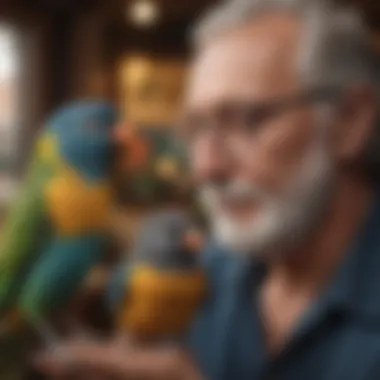
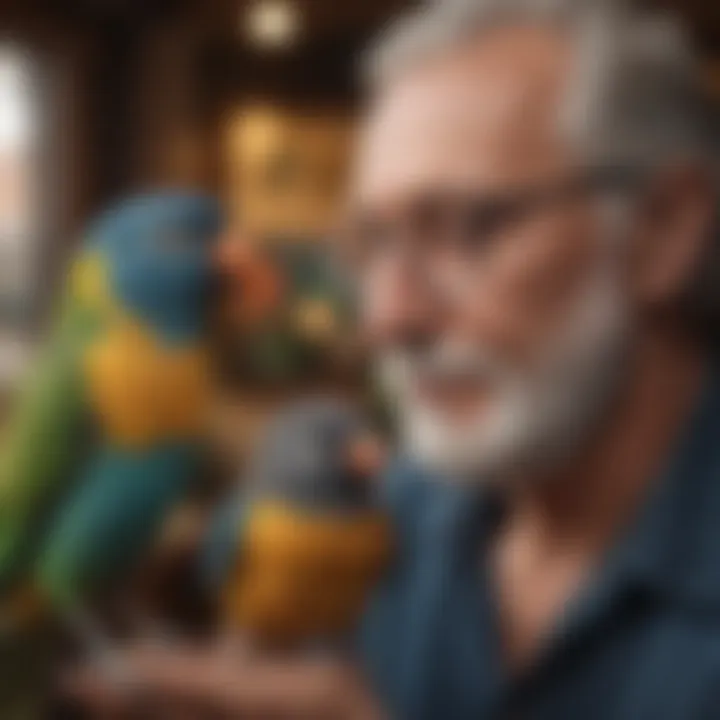
Setting a calendar for these appointments can help maintain health discipline for you as an owner too. Adopting a routine elevates the standard of care your birds receive.
Preventative Care Measures
Preventative care measures are critical in prolonging your bird’s life. Beyond routine check-ups, here are key aspects:
- Balanced diet: Ensure your bird gets a mix of seeds, pellets, fruits, and vegetables.
- Clean environment: Keep their living spaces clean to prevent infections and other illnesses.
- Social interaction: Boredom can lead to stress-related illnesses; therefore, providing constant interaction is helpful.
- Appropriate lighting: Exposure to natural daylight supports overall wellness, fostering normal activities.
Readers should refer to credible sources, such as Britannica and Reddit for community insights.
Having a healthy bird goes beyond just food—it's about creating an enriching environment tailored to their needs.
By focusing on health and wellness through these aspects, bird owners enhance the quality of life for their pets dramatically. Each small step ensures your feathered friends remain vibrant and content.
Enriching Activities for Pet Birds
The well-being of pet birds is intricately linked to their ability to engage in enriching activities. Having a stimulating environment enhances their physical and mental health. This section delves into diverse activities that are not only enjoyable for the birds but also vital for their happiness and overall development. Understanding and implementing these activities fosters a deeper connection between pet owners and their avian companions.
Interactive Playtime
Interactive playtime serves as a significant avenue for bonding between pet birds and their owners. This not only provides physical exercise but serves to sharpen mental skills. Birds thrive on social interaction, and play contributes to their behavioral development.
Consider these engaging activities:
- Toys for problem-solving: Investing in puzzles and activity toys that require the birds to think encourages them to use their beaks and claws while deftly engaging their minds.
- Out-of-Cage Time: Regularly providing your bird with time outside its cage is vital. This can occur in a controlled manner, such as being inside a bird-safe room.
- Varied Attack Strategies: Introduce different toys and rotate them to maintain their excitement. Each bird might have distinct preferences, making training through variety not only essential but fun.
Creating varied experiences stimulates curiosity and helps prevent boredom, which is critical for their mental health. Watch for your pet’s reaction; it could provide insight into its preferences and aversions.
Training and Mental Stimulation
Training holds incredible value for pet birds. Beyond basic commands, birds can learn complex tricks and solve challenges. This caters to their intelligence and natural behaviors. Simple commands not only strengthen the bond with avian companions but also effectively promote mental engagement.
When considering training, keep these points in mind:
- Positive Reinforcement: Always reward your bird with treats when it succeeds. This can reinforce desired behavior and help make the training enjoyable.
- Homemade Enrichment: Create your own training tools. Simple homemade toys or puzzles using safe household items can spark interest and challenge birds.
- Short Sessions: Keep training sessions short, typically around five to fifteen minutes. This limits mental fatigue and keeps the activity light, enjoyable, and effective.
Research suggests that regular training increases problem-solving capabilities, leading to decreased boredom and possible misbehaviors stemming from idle time.
Creating a Social Environment
Birds are inherently social creatures requiring interaction, not only with their human caregivers but, ideally, with other birds too. Formulating a collective social setting can mitigate stress among pet birds and allows them to thrive.
To enrich your bird's social environment, consider the following:
- Multiple Birds: If you have space and resources, consider adopting more than one bird. Variety in companionship can greatly enhance social behavior.
- Scheduled Playdates: Arrange for interactions with other pet birds or friends who keep birds. These controlled social events widen experiences and allow birds to display natural behaviors.
- Sharing the Space: Allow other pets, like dogs or cats, to coexist near the bird—while maintaining safety—to build their social cues.
A social atmosphere bolsters confidence in your birds and can alleviate behavioral issues like aggressiveness and residual stress. Birds flourish within their community, which enhances their holistic well-being.
Navigating Seasonal Changes
Understanding how to care for pet birds year-round is essential for their health and well-being. Seasonal changes present unique challenges and opportunities for enriching their lives. Your awareness of these variations is key to ensuring your feathered companions thrive throughout the year. By making necessary adjustments based on seasonal climatic conditions, you can create a supportive environment.
Adapting Care for Winter
Winter presents its own set of challenges for pet birds. The drop in temperature requires bird owners to take precautions to protect their pets from the cold. First, ensure that your aviary is properly insulated. Drafts can be harmful, and it's important to maintain a consistent, comfortable temperature.
Consider the following during winter:
- Explore avian-safe heaters to offer warmth without exposure risks.
- Limit exposure to direct cold air by closing windows when it's freezing outside.
- Introduce cozy nesting materials that offer warmth and security.
Provide adequate light since the days are shorter in winter. Birds require about 12 hours of light for their well being. You might use full-spectrum lights to mimic natural sunlight to encourage healthy behaviors and mood stability in your birds.
Summer Precautions
As the temperature rises, owners need to be mindful of heat-related issues. Birds are sensitive to extreme heat, so creating a comfortable environment is vital. Here are some actions to consider during hot months:
- Shade your aviary, minimizing direct sun exposure.
- Maintain good airflow within the cage; using fans can be beneficial.
- Hydration is critical. Always provide fresh water and consider adding ice cubes to keep their drinking water cool.
Likely, birds may also benefit from bath opportunities. Allowing them to bathe will help in regulating their body heat. Make sure to keep an eye on humidity levels and ensure they are not too high, as excess moisture can lead to health complications.
Maintaining a balanced habitat throughout the year involves understanding how seasonal shifts affect your bird's physical and mental health. Keeping adjustments manageable helps create a routine that allows them to enjoy various seasons.
Ending
In this section, we explore the significance of the commitment involved in caring for pet birds. Understanding the intricate relationship between birds and their owners is pivotal to nurturing healthy, thriving companions. The joys of having birds as pets come with responsibilities. Terms like lifelong commitment recall the sacrifices, clients ensure with options such as consistent warmth, stimulation, and accessibility.
A Lifelong Commitment
Owning a pet bird entails a long-term relationship. A variety of species can live many years. For example,
- Parakeets have lives averaging 5 to 10 years,
- Cockatiels can live from 10 to 15 years,
- Larger parrots like Amazon Parrots often surpass 30 years.
This extensive lifespan means owners must prepare for shifts in lifestyle as the bird ages. Success involves pays when routines and social interactions adapt. Owners must prioritize care considerations like diet, companionship, and avian health. Factors such as offering familiar environmental support greatly contribute to improved well-being.
Only through understanding the emotional significance of the bond can owners ensure both parties live in harmony.
Key aspects of this commitment include:
- Regular veterinary checkups.
- Understanding behavioral signs that indicate stress or sickness.
- Dedicating enrichment time through play and social interactions rather than the eyes of the world.
Resources for Continued Learning
To support owners throughout their journey, continuous education remains essential. As pet bird trends evolve, ensuring proper care becomes paramount. Trusted resources offer substantial depth in avian care. Consider diving into sources like:
- Wikipedia (www.wikipedia.org) for foundational knowledge on specific bird species.
- Reddit's avian communities (www.reddit.com) for real-world experiences and Q&A.
- Facebook groups targeting pet bird owners to interact.
- Britannica (www.britannica.com) for articles on common issues and solutions regarding bird ownership.
Overall, keeping up-to-date with new research, best practices, and community experiences ostensibly fortifies one's capabilities as a pet owner. By engaging with these resources, you forge a nourishing environment for your feathered friend and develop a resilient understanding that truly enhances the journey together.















